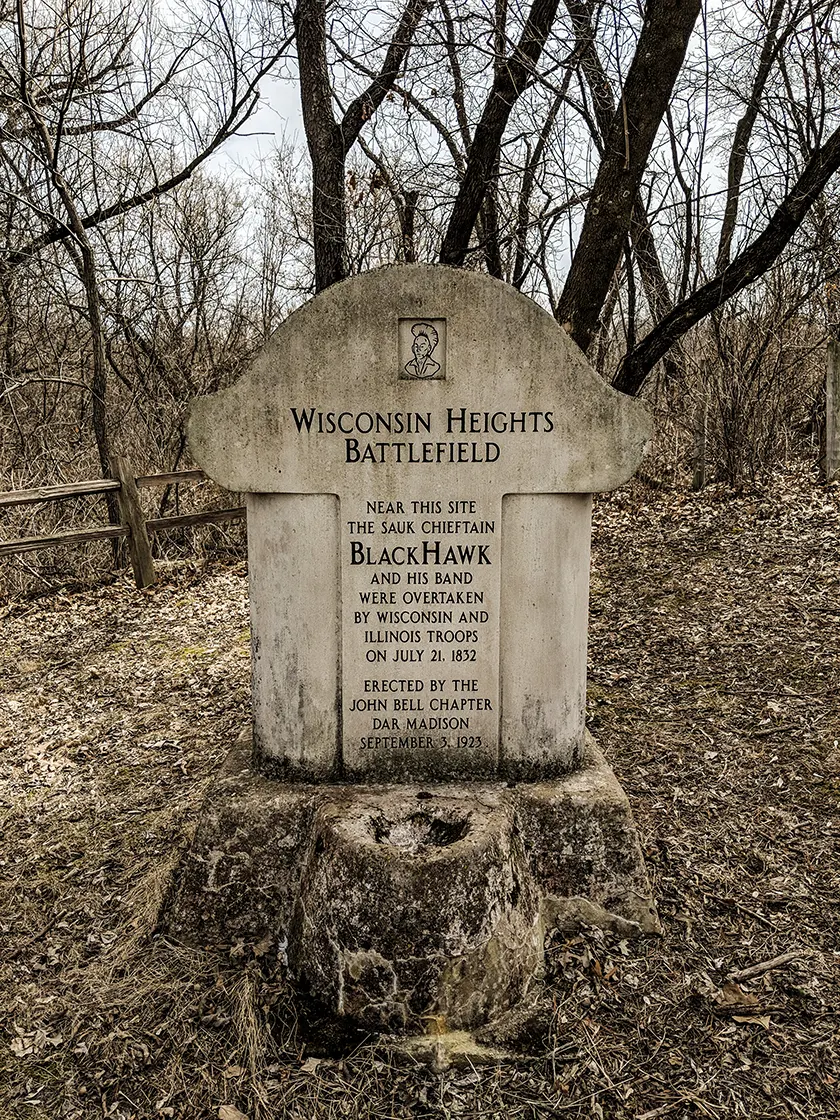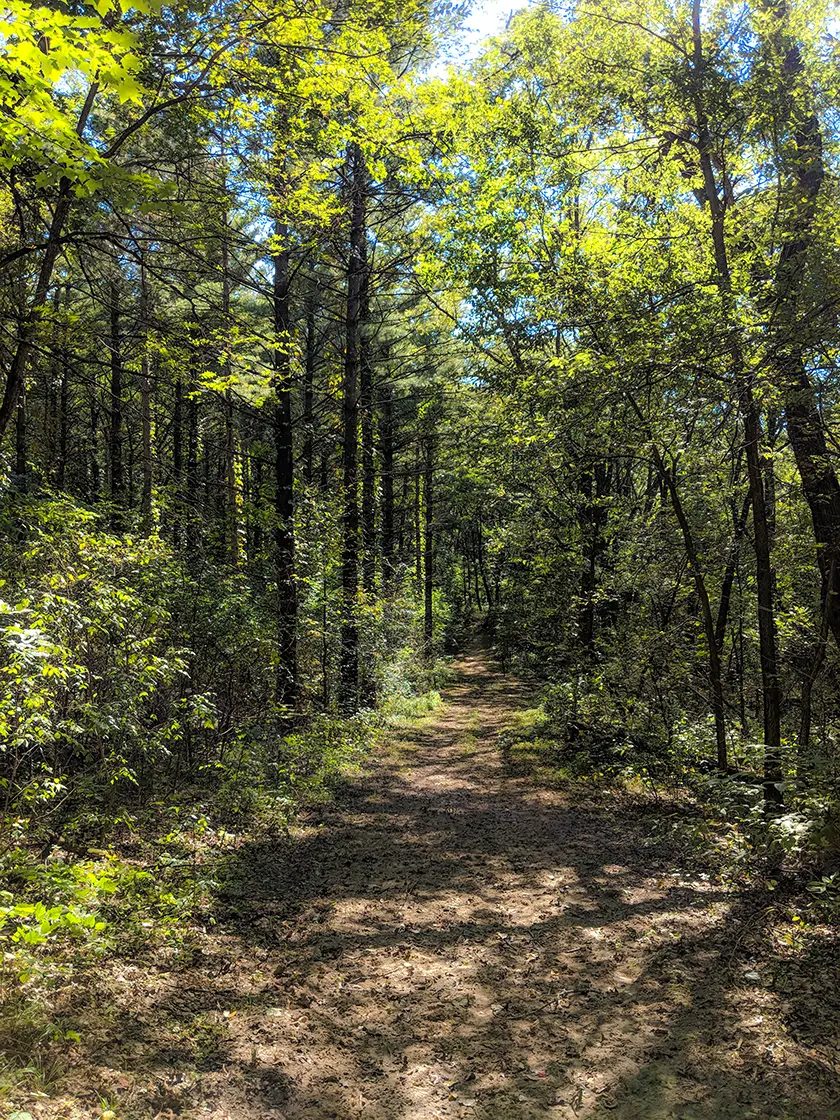The Black Hawk Unit of the Lower Wisconsin Riverway, known locally as Blackhawk Ridge, is an 815-acre recreational area, archeological site, and national landmark occupying a range of high mounds overlooking the south bank of the Wisconsin River across from Sauk City.
Part of the park is known to historians as Wisconsin Heights where Black Hawk and his British Band were first defeated by the Michigan and Illinois Militia. Black Hawk and 600 of his followers, mostly women, children, and elderly managed to escape as the battle occurred only to later be massacred at the battle of Bad Axe. The Battle of Wisconsin Heights is commemorated with a Wisconsin Historic Marker and Grand Army of the Republic memorial.
The area today is a quiet and peaceful retreat featuring 12-miles of interconnected hiking and bridle trails. It is mainly used for horseback riding and includes stables and a riding arena.
In this article, I'll provide a brief overview of the Battle of Wisconsin Heights and describe the hiking trails in detail. Included is a detailed GPS recorded map of the hiking trails overlayed with information about the battleground.
{tocify} $title={Table of Contents}
$ads={1}
advertisement

|
| Bridle and Hiking Trail at Lower Wisconsin Riverway Blackhawk Unit |
THE ENDURING LEGEND OF BLACK HAWK
The Black Hawk War has an enduring hold on the imagination of Wisconsinites. Nearly every small town, village, and city in the southern half of the state proudly lay claim to their historic role in the Black Hawk Wars with memorials and interpretive signs, most downplaying the fact that they were helplessly raided and victimized by decentralized raiding parties of Black Hawk's British Band. From golf courses to segments of a national trail, to the name of a technical college, the Black Hawk name to this day memorializes the frontier battles in the summer of 1832.
The effect of the Black Hawk campaign on the history of the United States is noteworthy. News of the frontier violence captured the fascination of people in Atlantic coast cities and sent shivers across the new nation. It crystalized the public mythology of American Indians as ferocious aggressors. Indian policy followed public sentiment with Indian Removal becoming an official priority policy following the Black Hawk War.
The brief campaign and its participants were instantly elevated to legendary status. None more than Black Hawk himself whose name today inspires more respect and recognition than that of his adversaries Dodge and Atkinson. On the American side, participants in the militia actions earned their stripes in the campaign and many rode the legend to positions of influence. Colonel Dodge, who led the battle at Wisconsin Heights, was promoted to the rank of Major General and was later appointed the first Governor of the Wisconsin Territory. He would eventually lead the territory to statehood. Not to be forgotten, the two great adversaries of the Civil War, Abraham Lincoln and Jefferson Davis, both served for the American militia forces in the Black Hawk War.
Resistance on the Frontier
Though the effects of the Black Hawk War are widely recognized, few are aware of how it all began. Following the treaty of St. Louis, Sauk leader Black Hawk led a group of 500 warriors and 600 civilians into Illinois in a move to resettle heritage land, reclaiming the village of Saukernuk where Black Hawk had been born and raised. His band of followers was called the British Band by Americans, Black Hawk had fought for the British in the War of 1812.
At Stillman's Creek, a 260-man American militia confronted 40 of Black Hawk's warriors and opened fire on three of Black Hawk's men as they approached under a white flag. Black Hawks warriors subsequently routed the larger militia force, forcing a humiliating retreat. This embarrassment triggered an overreaction by the US military which resulted in the end of diplomatic attempts to quell aggressions and the assembly of an overwhelming force emotionally determined to eradicate the entire British Band.
With conflict now underway, Black Hawk took advantage of the disorganized US forces led by General Henry Atkinson. Black Hawk conducted a series of raids on American settlements, which were unprotected as local men joined the militias being organized for the pursuit. Raids continued between May and July of 1832. Several skirmishes with American forces resulted in victories for the British Band.
The Battle of Wisconsin Heights
By late July, the British Band had been reduced to 600 people, mostly civilians, who were being pursued by 750 militiamen as they raced to escape west of the Mississippi River. On July 21st, Black Hawk held a mound at Wisconsin Heights where the band was organizing to cross the Wisconsin River. This is where Colonel Dodge finally caught up with Black Hawk. The Battle of Wisconsin Heights was the first major victory for Atkinson's American forces. Approximately 67 of Black Hawk's remaining 100 warriors were killed in the battle. Still, the British Band's rearguard action was successful in providing cover for the escape of 500 civilians across the Wisconsin River.
Hiking The Battlefield
The Wisconsin Heights battlefield today is crisscrossed with hiking trails which outline some of the key features of the battle. The entrance to the battlefield trails is at a small parking lot featuring a Wisconsin Historic Marker. Standing in the parking lot, you will immediately perceive the high mound that Black Hawk occupied to the southeast of the parking lot. The trail heading east from the parking lot traces a ridgeline that rises above a creek and wetland. This ridgeline was held by Black Hawk's warriors as they faced off against the American forces positioned to the north.
Continuing on the gold trail that I have outlined on the map on this page, you will cross the valley and stream which was called the Spy's Ravine. The Spy's ravine was the skirmish line that divided the American forces from the British Band. The trail on the north side of Spy's Ravine outlines the base of Militia Ridge, the high ground held by the Americans. Hiking to the east will take you on a loop encircling the American position. As you look across the Spy's ravine you can see a prominent mound known as Sharpshooter's Lookout. This was the position held by Black Hawk's sharpshooters.
The battle was ended by a heroic bayonet charge from Militia Ridge across the Spy's Ravine which isolated shooters at Sharpshooter's Lookout. Outnumbered 7-to-1, Black Hawk's warriors succumbed. But, the British Band had fought out the day before surrendering. With night approaching, the militia decided not to pursue Black Hawk until the morning. This provided time for Black Hawk to escape across the Wisconsin River with women, children, and elderly during the night. The British Band continued their push to escape west of the Mississippi River and had nearly made it. They were gunned down as they attempted to cross the Mississippi in a hideous massacre of non-combatant American Indians.
Black Hawk survived, and as part of his punishment was paraded through East Coast cities for the fascination of citizens who had attentively followed reports of the frontier battles, an act which had the unintended consequence of further cementing his legendary status.
The Black Hawk Unit of the Lower Wisconsin Riverway
The recreational area that preserves the Wisconsin Heights Battlefield encompasses a staggering 850-acres of thickly forested hills overlooking the Wisconsin River. Twelve miles of trails climb the heights. These trails are wide two track pedestrian roads that form a knot of interconnected loops. It is a quiet place that is infrequently used compared to nearby state and county parks of similar size. It is unlikely that you will encounter other hikers along the trail.
The center of the park is on a high plateau at the end of Watcher Road where a large parking area, historic cabin, stables, riding arena, and picnic shelter are grouped. The trails emanating from this center are all designated as bridle trails, but horseback traffic is sparse. I have encountered a rider only once on my hikes at Black Hawk Unit.
Watcher Road is closed from Fall through Spring; there are three parking areas along Highway 78 which are open year-round for accessing hiking trails. The first parking lot is the one with the historical marker, a lot used for access to the battlefield trails. An additional spur trail from this lot leads to a set of Paleoindian mounds. The trails at the battlefield are the easiest for hiking and the most popular routes.

|
| GAR Memorial for Wisconsin Heights Battlefield |
Blackhawk Ridge Hiking Trails
COUNTY: Dane
COMMUNITIES: Mazomanie
TOTAL MILES: 12-mile network
DIFFICULTY: Easy-Difficult
Directions and Trail Map
Click Map Image to load the full interactive map.
Address for your GPS: 7000 WI-78 Trunk, Mazomanie, WI 53560
| coordinates: 43.244709, -89.723420 |
| From Milwaukee | 2 Hours |
| From Madison | 30 minutes |
| From Green Bay | 3 Hours |
| From Wausau | 2 Hours |
| From Minneapolis | 4 Hours |
| From Chicago | 4 Hours |
Photos

|
| Historic Interpretive Sign for Battle of Wisconsin Heights |

|
| Trail at Lower Wisconsin Riverway Blackhawk Unit |

|
| Overlook at Lower Wisconsin Riverway Blackhawk Unit |

|
| Cabin and riding arena at Lower Wisconsin Riverway Blackhawk Unit |

|
| Bridle and hiking trail at Lower Wisconsin Riverway Blackhawk Unit |

|
| American Indian mounds at Blackhawk Unit of the Lower Wisconsin Riverway |

|
| Trail at Lower Wisconsin Riverway Blackhawk Unit |

|
| Picnic Shelter at Blackhawk Unit of the Lower Wisconsin Riverway |

|
| Cabin at Blackhawk Unit of the Lower Wisconsin Riverway |

|
| Inside the Cabin at the Blackhawk Unit of the Lower Wisconsin Riverway |

|
| Prairie grass at the Blackhawk Unit of the Lower Wisconsin Riverway |


